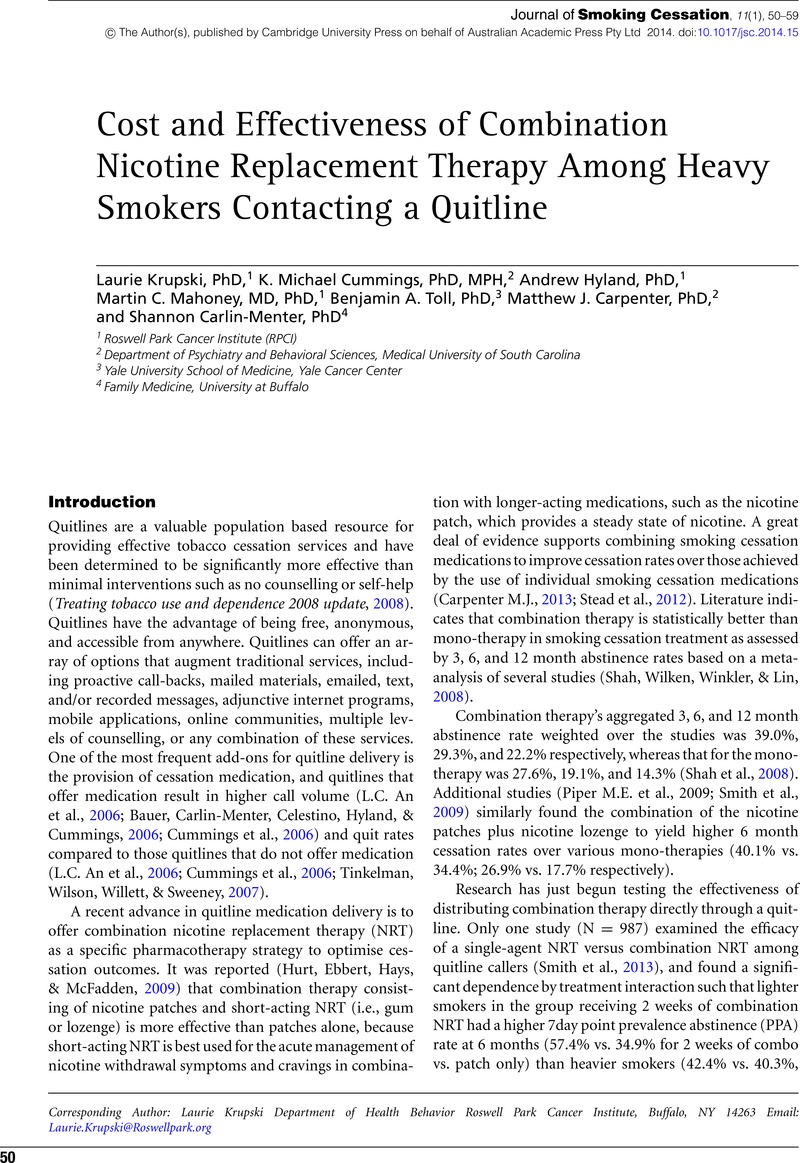Crossref Citations
This article has been cited by the following publications. This list is generated based on data provided by Crossref.
Hartmann-Boyce, Jamie
Chepkin, Samantha C
Ye, Weiyu
Bullen, Chris
and
Lancaster, Tim
2018.
Nicotine replacement therapy versus control for smoking cessation.
Cochrane Database of Systematic Reviews,
Vol. 2019,
Issue. 1,
Reisinger, Sarah A.
Kamel, Sahar
Seiber, Eric
Klein, Elizabeth G.
Paskett, Electra D.
and
Wewers, Mary Ellen
2019.
Cost-Effectiveness of Community-Based Tobacco Dependence Treatment Interventions: Initial Findings of a Systematic Review.
Preventing Chronic Disease,
Vol. 16,
Issue. ,
Lindson, Nicola
Chepkin, Samantha C
Ye, Weiyu
Fanshawe, Thomas R
Bullen, Chris
and
Hartmann-Boyce, Jamie
2019.
Different doses, durations and modes of delivery of nicotine replacement therapy for smoking cessation.
Cochrane Database of Systematic Reviews,
Vol. 2019,
Issue. 4,
Leung, Maria K. W.
Bai, Dan
Yip, Benjamin H. K.
Fong, M. Y.
Lai, Petty M. H.
Lai, Phoebe
Lai, Irene S. Y.
Lam, Zoe H. W.
Leung, Andrew T. F.
To, Dorothy K Y
Wong, M. T.
Wong, T. K.
and
Chao, David V. K.
2019.
Combined nicotine patch with gum versus nicotine patch alone in smoking cessation in Hong Kong primary care clinics: a randomised controlled trial.
BMC Public Health,
Vol. 19,
Issue. 1,
Baker, Timothy B.
and
McCarthy, Danielle E.
2021.
Smoking Treatment: A Report Card on Progress and Challenges.
Annual Review of Clinical Psychology,
Vol. 17,
Issue. 1,
p.
1.
Thomas, Kyla H
Dalili, Michael N
López-López, José A
Keeney, Edna
Phillippo, David
Munafò, Marcus R
Stevenson, Matt
Caldwell, Deborah M
and
Welton, Nicky J
2021.
Smoking cessation medicines and e-cigarettes: a systematic review, network meta-analysis and cost-effectiveness analysis.
Health Technology Assessment,
Vol. 25,
Issue. 59,
p.
1.
Chen, Brian
Silvestri, Gerard A.
Dahne, Jennifer
Lee, Kyueun
and
Carpenter, Matthew J.
2022.
The Cost-Effectiveness of Nicotine Replacement Therapy Sampling in Primary Care: a Markov Cohort Simulation Model.
Journal of General Internal Medicine,
Vol. 37,
Issue. 14,
p.
3684.
Theodoulou, Annika
Chepkin, Samantha C
Ye, Weiyu
Fanshawe, Thomas R
Bullen, Chris
Hartmann-Boyce, Jamie
Livingstone-Banks, Jonathan
Hajizadeh, Anisa
and
Lindson, Nicola
2023.
Different doses, durations and modes of delivery of nicotine replacement therapy for smoking cessation.
Cochrane Database of Systematic Reviews,
Vol. 2023,
Issue. 6,
Theodoulou, Annika
Fanshawe, Thomas R
Leavens, Eleanor
Theodoulou, Effie
Wu, Angela Difeng
Heath, Laura
Stewart, Cristina
Nollen, Nicole
Ahluwalia, Jasjit S
Butler, Ailsa R
Hajizadeh, Anisa
Thomas, James
Lindson, Nicola
and
Hartmann-Boyce, Jamie
2025.
Differences in the effectiveness of individual-level smoking cessation interventions by socioeconomic status.
Cochrane Database of Systematic Reviews,
Vol. 2025,
Issue. 1,



